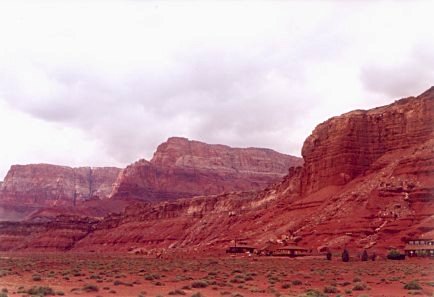The Vermilion Cliffs are one of the most visually striking and geologically rich landscapes in the American Southwest. Located in northern Arizona and stretching into southern Utah, these vibrant, multi-colored cliffs form part of the expansive Grand Staircase and have become a symbol of natural beauty and wilderness preservation. The area is protected as Vermilion Cliffs National Monument, a federally designated site established in 2000 during the Clinton administration. Covering approximately 294,000 acres, the monument is managed by the U.S. Bureau of Land Management and remains largely undeveloped and remote, with no paved roads, campgrounds, or visitor centers.
Geologically, the Vermilion Cliffs are composed of sedimentary rock layers that date back over 190 million years. These layers include ancient sand dunes and marine deposits that have hardened over time into rock and then eroded into a stunning display of red, orange, pink, and white strata. These cliffs form the second step in the Grand Staircase, a series of plateaus descending from Bryce Canyon to the Grand Canyon. This natural staircase showcases the Earth’s geological history in an unbroken sequence of rock formations.
Among the most famous features within the monument is The Wave, a unique sandstone formation located in the Coyote Buttes North area. Known for its smooth, undulating surfaces and surreal patterns, The Wave has become an iconic destination for photographers and hikers. Due to its fragile nature and the high volume of visitors, access to The Wave is strictly limited by a permit system. Another notable area is Coyote Buttes South, which offers equally impressive rock formations and far fewer crowds, making it a favorite among those seeking solitude and natural beauty.
Other highlights within the monument include the Paria Plateau and Buckskin Gulch. The Paria Plateau is an elevated region that offers panoramic desert views and is home to delicate rock structures shaped by wind and water. Buckskin Gulch is one of the longest and deepest slot canyons in the United States and is popular with backpackers and experienced hikers. Despite the remote conditions, these areas attract visitors who are prepared for rugged travel and self-reliance.
The ecosystem within the Vermilion Cliffs is home to a variety of desert wildlife. One of the most significant conservation successes in the region is the reintroduction of the California condor. These massive birds, once nearly extinct, now soar over the cliffs thanks to ongoing efforts by wildlife biologists. Other animals include desert bighorn sheep, coyotes, foxes, rattlesnakes, lizards, and numerous bird species. The lack of development and limited human presence has helped maintain the natural balance of this delicate environment.
Culturally and historically, the Vermilion Cliffs area is rich in significance. It contains ancient petroglyphs, pictographs, and ruins linked to the Ancestral Puebloan people, also known as the Anasazi. Native American tribes such as the Hopi, Navajo, and Paiute consider the region sacred and continue to maintain cultural ties to the land.
Visitors to the Vermilion Cliffs must plan carefully. The nearest towns are Page, Arizona, and Kanab, Utah, both of which provide limited services for travelers. Accessing the monument often requires high-clearance, four-wheel-drive vehicles, and visitors are advised to carry sufficient water, food, and emergency supplies. There are no facilities inside the monument, and cell service is often unavailable.
Environmental threats to the Vermilion Cliffs include wildfires, such as the nearby White Sage Fire, which has burned tens of thousands of acres. These fires not only threaten wildlife but also impact air quality and pose a risk to hikers and remote structures. Other challenges include tourism pressure, especially at The Wave, and the broader effects of climate change, such as prolonged drought and habitat disruption.
Despite these challenges, the Vermilion Cliffs remain a protected and awe-inspiring landscape that offers a rare glimpse into the natural and cultural heritage of the American Southwest.







